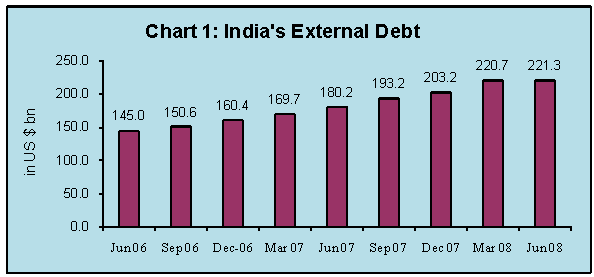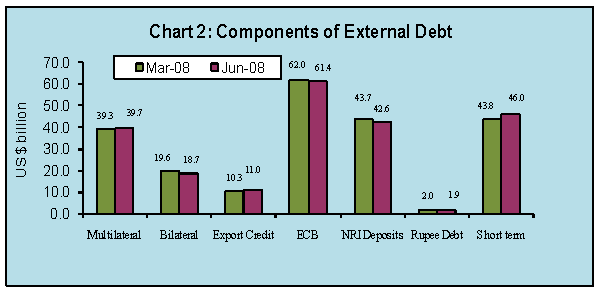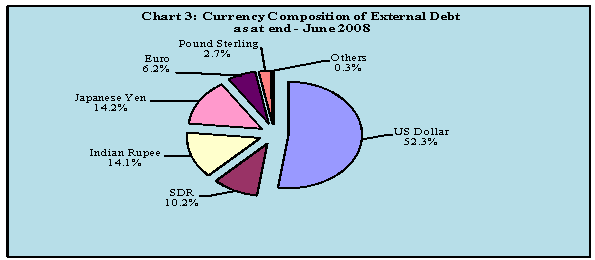 IST,
IST,


India’s External Debt as at the end of June 2008
As per the extant practice, India's external debt statistics for the quarters ending March and June are compiled and released by the Reserve Bank, while the external debt data for quarters ending September and December are compiled and released by the Ministry of Finance, Government of India. A detailed account of external debt as compiled in the standard format as at end-June 2008 in rupee and US dollar terms and revised data for earlier quarters are set out in Statement 1 and 2, respectively. 1. Stock of External Debt The external debt was placed at US $ 221.3 billion at the end of June 2008 as against US $ 220.7 billion at end-March 2008 recording an increase of US $ 0.6 billion or 0.3 per cent over the end-March 2008 level (Table 1 and Chart 1). 2. Valuation Changes The valuation effect reflecting the appreciation of the US dollar against other major international currencies and Indian rupee resulted in a decline in external debt by US $ 4.5 billion. This implies that excluding the valuation effects, the stock of external debt as at end-June 2008 increased by US $ 5.1 billion over the end-March 2008 level. 3. Components of External Debt The rise in external debt stock was essentially due to increase in short term debt which rose by US $ 2.2 billion during the quarter. The data on short term debt include both suppliers’ credit up to and above 180 days and FII investment in Government debt papers. The rise in short-term debt was mainly on account of rise in trade credit (in particular, trade credits above 180 days) attributed to the higher financing of imports during the quarter. Outstanding NRI deposits at US $ 42.6 billion as at end-June 2008 recorded a decline of US $ 1.1 billion over the level at end-March 2008. Despite inflows under NRI deposits during the quarter, the above decline in outstanding was mainly on account of valuation effect. The movements in the other components of external debt as at end June 2008 revealed that while there was an increase in multilateral debt and export credit, commercial borrowings, bilateral debt and rupee debt showed decline (Table 2 and Chart 2). Table 2: Variation in External Debt by Components
Note: Figures in parentheses indicate share to total debt. 4. External Debt by Residual Maturity While external debt is generally compiled in terms of original maturity, analysing the external debt in terms of residual maturity is important from the point of view of forex liquidity management and to ascertain the total forex outgo on account of debt service payments in the immediate future. The ‘long term debt by residual maturity’ comprises the repayments due after one year under medium and long term debt by original maturity. On the other hand, the ‘short-term debt by residual maturity’ comprises the repayments due under medium and long-term debt by original maturity during one year reference period along with the short-term debt with original maturity. Based on residual maturity, out of total external debt of US $ 221.3 billion as at end-June 2008, long-term debt accounted for US $ 132.3 billion or 59.8 per cent. Short-term debt by residual maturity at end-June 2008 stood at US $ 89.0 billion accounting for 40.2 per cent of the total external debt. The ratio of short-term debt by residual maturity to foreign exchange reserves was 28.5 per cent at end-June 2008 (Table 3). Table 3: Residual Maturity of External Debt outstanding as at end-June 2008
Notes: 1. Residual Maturity of NRI Deposits is estimated on the basis of the Survey conducted by the Reserve Bank on NRI deposits outstanding as on March 31, 2008. 2. The maturity pattern of NRO Deposits that was not available in the March 31, 2007 survey is now available in the March 31, 2008 survey. The maturity-wise break up of NRO deposits are thus, given. 3. FII investment in treasury bills and government dated securities are included under sovereign debt, while FII investment in corporate debt papers and other short-term debt instruments are included under Commercial Borrowings. 5. Currency Composition While the US dollar is generally used as the numeraire currency for computing external debt in order to facilitate international comparison, the currency composition of the external debt is essential to understand the currencies in which the debt is actually denominated and hence the extent of the economy’s vulnerability to solvency and liquidity risks. It also gives an idea of the extent of exposure of the economy to cross currency exchange rate movements. The currency composition of India’s external debt is generally disseminated in terms of major foreign currencies such as US dollars, Japanese yen, Euro, Pound Sterling, Special Drawing Rights (SDR) and the domestic currency i.e., Indian rupee. In this regard, it is stated that while calculating currency composition, the short term trade credit was generally taken to be in dollars as most of it was denominated in US dollars. However, recognising the growing volume of such credits in the recent years on the back of burgeoning imports and the increasing significance of currencies other than US dollar in the short term credit, the original currency breakup of the short term trade credit above 180 days was computed for end-March 2008 and end-June 2008. It was observed that about 70 per cent of the short term trade credit is denominated in US dollars, 14 per cent in yen, 13 per cent in Euro and the balance in other currencies. Looking at the overall external debt position, the US Dollar continues to remain the predominant currency accounting for 52.3 per cent of the total external debt stock as at the end of June 2008, followed by the Japanese yen (14.2 per cent), Indian rupee (14.1 per cent) and SDR (10.2 per cent) (Table 4 and Chart 3). The share of Euro has seen a rise from 4.0 per cent as at end-March 2007 to 6.2 per cent as at end-June 2008. Table 4: Currency Composition of External Debt
Notes: 1. Currency composition as at end-March 2008 and end-June 2008 incorporates the original currency composition of short term debt unlike in the previous years where the entire short term debt has been taken to be denominated in US dollars. 2. Currency composition of short term debt outstanding is estimated on the basis of the original currency composition of short term debt inflows during 2007-08. 6. Indicators of Debt Sustainability The external debt sustainability indicators of India are set out in Table 5.
Table 5: India’s Key External Debt Indicators
* Works out to 12.4 %, with the exclusion of prepayment of external debt of US $ 3,430 million In absolute terms, the debt service payments amounted to US $ 3.2 billion during April-June 2008 (Table 6). During the quarter, around 62.4 per cent of debt service payments, inclusive of principal and interest, were on account of ECBs followed by 25.7 per cent in respect of external assistance. Table 6: India’s External Debt Service Payments
# Current Receipts Minus Official Transfers; *: April-June 2008. 7. Cross Country Comparison Comparing the cross country data on external debt provided by the World Bank in the Global Development Finance, 2008 for the year 2006 for the top twenty debtor countries of the developing world reveal the following (Table 7):
Table 7: International Comparison of Top 20 Debtor Countries, 2006
Source: Data for India are as published by national authorities for 2006-07 and those for other countries are at end-December 2006 as available in World Bank’s Global Development Finance, 2008. Alpana Killawala Press Release : 2008-2009/414 |
||||||||||||||||||||||||||||||||||||||||||||||||||||||||||||||||||||||||||||||||||||||||||||||||||||||||||||||||||||||||||||||||||||||||||||||||||||||||||||||||||||||||||||||||||||||||||||||||||||||||||||||||||||||||||||||||||||||||||||||||||||||||||||||||||||||||||||||||||||||||||||||||||||||||||||||||||||||||||||||||||||||||||||||||||||||||||||||||||||||||||||||||||||||||||||||||||||||||||||||||||||||||||||||||||||||||||||||||||||||||||||||||||||||||||||||||||||||||||||||||||||||||||||||||||||||||||||||||||||||||||||||||||||||||||||||||||||||||||||||||||||||||||||||||||||||||||||||||||||||||||||||||||||||||||||||||||||||||||||||||||||||||||||||||||||||||||||||||||||||||||||||||||||||||||||||||||||||||||||||||||||||||||||||||||||||||||||||||||||||||||||||||||||||||||||||||||||||||||||||||||||||||||||||||||||||||||||||||||||||||||||
పేజీ చివరిగా అప్డేట్ చేయబడిన తేదీ:




















